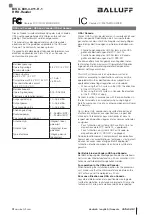
FOR MOBILE APPLICATIONS
W25Q256FV
Publication Release Date: May 13, 2012
- 12 - Preliminary - Revision M1
6.2
Write Protection
Applications that use non-volatile memory must take into consideration the possibility of noise and other
adverse system conditions that may compromise data integrity. To address this concern, the W25Q256FV
provides several means to protect the data from inadvertent writes.
•
Device resets when VCC is below threshold
•
Time delay write disable after Power-up
•
Write enable/disable instructions and automatic write disable after erase or program
•
Software and Hardware (/WP pin) write protection using Status Registers
•
Additional Individual Block/Sector Locks for array protection
•
Write Protection using Power-down instruction
•
Lock Down write protection for Status Register until the next power-up
•
One Time Program (OTP) write protection for array and Security Registers using Status Register
*
* Note:
This feature is available upon special order. Please contact Winbond for details.
Upon power-up or at power-down, the W25Q256FV will maintain a reset condition while VCC is below the
threshold value of V
WI
, (See Power-up Timing and Voltage Levels and Figure 43). While reset, all
operations are disabled and no instructions are recognized. During power-up and after the VCC voltage
exceeds V
WI
, all program and erase related instructions are further disabled for a time delay of t
PUW
. This
includes the Write Enable, Page Program, Sector Erase, Block Erase, Chip Erase and the Write Status
Register instructions. Note that the chip select pin (/CS) must track the VCC supply level at power-up until
the VCC-min level and t
VSL
time delay is reached.
After power-up the device is automatically placed in a write-disabled state with the Status Register Write
Enable Latch (WEL) set to a 0. A Write Enable instruction must be issued before a Page Program, Sector
Erase, Block Erase, Chip Erase or Write Status Register instruction will be accepted. After completing a
program, erase or write instruction the Write Enable Latch (WEL) is automatically cleared to a write-
disabled state of 0.
Software controlled write protection is facilitated using the Write Status Register instruction and setting the
Status Register Protect (SRP0, SRP1) and Block Protect (CMP, TB, BP[3:0]) bits. These settings allow a
portion or the entire memory array to be configured as read only. Used in conjunction with the Write
Protect (/WP) pin, changes to the Status Register can be enabled or disabled under hardware control. See
Status Register section for further information. Additionally, the Power-down instruction offers an extra
level of write protection as all instructions are ignored except for the Release Power-down instruction.
The W25Q256FV also provides another Write Protect method using the Individual Block Locks. Each
64KB block (except the top and bottom blocks, total of 510 blocks) and each 4KB sector within the
top/bottom blocks (total of 32 sectors) are equipped with an Individual Block Lock bit. When the lock bit is
0, the corresponding sector or block can be erased or programmed; when the lock bit is set to 1, Erase or
Program commands issued to the corresponding sector or block will be ignored. When the device is
powered on, all Individual Block Lock bits will be 1, so the entire memory array is protected from
Erase/Program. An “Individual Block Unlock (39h)” instruction must be issued to unlock any specific sector
or block.
The WPS bit in Status Register-3 is used to decide which Write Protect scheme should be used. When
WPS=0 (factory default), the device will only utilize CMP, TB, BP[3:0] bits to protect specific areas of the
array; when WPS=1, the device will utilize the Individual Block Locks for write protection.














































